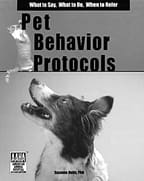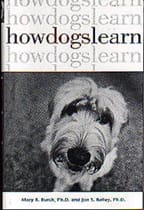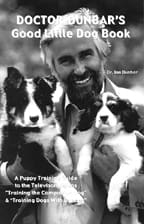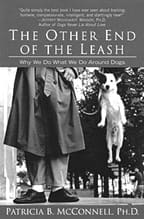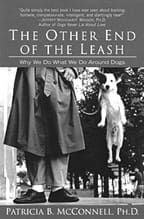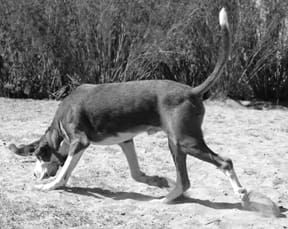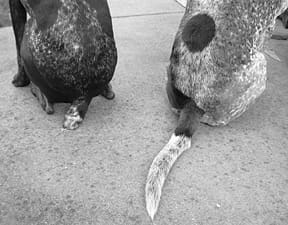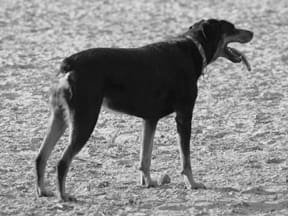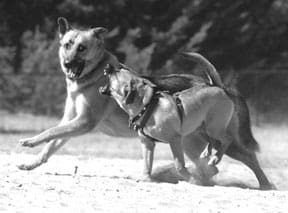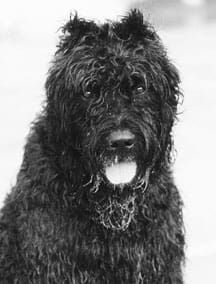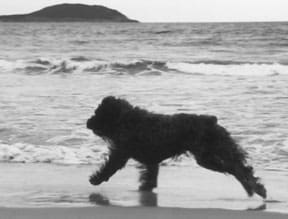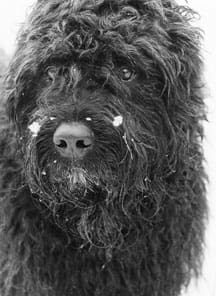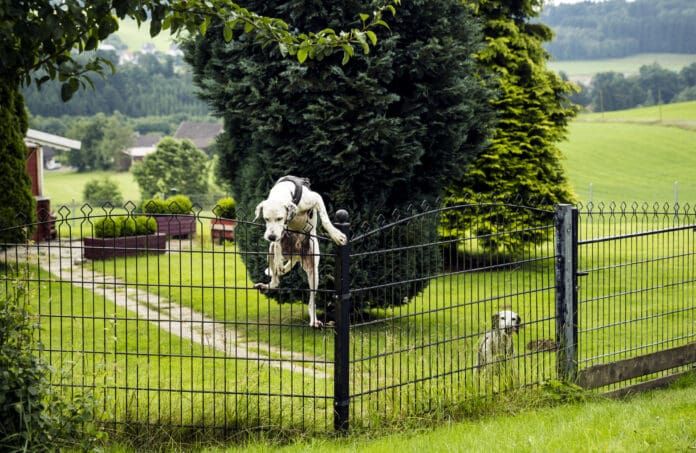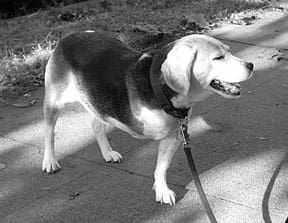When the dog’s skin is healthy, we don’t give it a second thought. But when it is out of whack – greasy, itchy, smelly, flaky, bumpy, or raw – it becomes the center of attention for our dogs, and us, too. There is no more miserable dog than one with a serious skin problem.
The skin is the epithelial and connective tissue covering of the body. Skin is also referred to as the “integument,” a term meaning “a covering or investment.” Cutaneous is also used to describe the skin.
An animal’s skin is its largest organ of the body, and it is properly thought of as a living, breathing organ system with a multitude of functions, specific nutrient needs, and intimate interconnections with other organ systems of the body. Of particular interest to health and healing are the functions of the skin that involve inner-body protective mechanisms, whole-body immunology, and nervous functions that affect sensation.
The surface of the skin is a critical interface between the highly controlled internal tissues and the external environment. It permits the maintenance of bodily homeostasis, and it is a primary organ system for creating and maintaining whole-body health.
Anatomy and physiology
Skin is composed of two integrated cell layers, the epidermis and dermis. In total, the skin acts as a semipermeable protective layer covering the entire body.
The epidermis is the nonvascular, outermost layer of the skin and is composed of several cell layers. It is the tough part of the skin, and it has the ability to thicken with use. The epidermis varies in thickness, depending on the area of the body, but over most of the body it is about 0.1 mm thick. A dog’s foot pads are greatly thickened and toughened epidermis.
The dermis is the part of the skin that lies beneath the epidermis; it is composed mostly of connective tissue along with blood vessels, nerves, and lymphatic ducts.
In the skin two particular cell types, keratinocytes and Langerhans cells, are of special importance for holistic health. Both are prime contributors to the health and healing of the skin.
Keratinocytes are stratified (in layers) squamous (scaly or platelike) epithelial cells, which are the primary cells found in the skin and mucosa, including oral esophageal, corneal, conjunctival, and genital epithelium. Ninety-five percent of the epidermal cells are keratinocytes. Keratin is an insoluble protein synthesized by keratinocytes. Keratin adds toughness to skin, hair, and nails; it the substance that forms a barrier between the animal and the environment.
Keratinocytes undergo characteristic changes as they move upward/outward from the basal layers of the epidermis (the deepest layer of keratinocytes where the stem cells reside) to the outer cornified (hardened) layers of the skin. The normal turnover time for keratinocytes is about 30 to 60 days, but this time may vary with disease or patterns of increased use.
Langerhans cells form the “nerve cen-ter” of the skin; they are migrating dendritic cells (from the Greek, dendron, for tree) found in the epidermis. These are cells of nervous tissue origin that participate in the cutaneous immune response. They have the ability to migrate from the skin to lymph nodes where they can transfer antigenic information being received by the skin throughout the entire body. Their communicative ability is greatly enhanced by their extensive “dendrites” – branching, threadlike extensions (like the limbs of a tree) from the cell proper.
Melanocytes are cells found in both the epidermis and dermis; they contain pigmented granules of melanin. Melanin granules are all the same color (reddish-brown); it is the variation in the amount and location of melanin that causes the different colors of skin and fur.
The subcutaneous layer lies below the epidermis and dermis. It is composed mostly of fat, and it forms a loose attachment between the dermis and underlying muscle tissue. Its loose attachment allows for considerable movement of the dog’s skin over its body.
Structures that originate from the skin include hair or fur, glands, and nails.
Most mammals have both oil (sebaceous) and sweat (sudoriferous) glands located throughout the skin, but the dog’s (and cat’s) sweat glands are found only on the pads of their feet. Panting (along with increased salivation) are the primary ways a dog cools down.
Sebaceous or oil glands are usually associated with a hair follicle, and they are widely distributed throughout the skin of most mammals. Secretory cells of the sebaceous glands produce sebum, a substance that is mostly lipid (fatty material).
The functions of the sebaceous glands include:
• Lubrication and production of a protective, oily layer for the hair and skin.
• Inhibition of bacterial growth.
• Synthesizing vitamin D. (A precursor to vitamin D, dehydrocholestrol, is formed in sebaceous glands. When dehydrocholestrol is irradiated by sunlight to its active form, vitamin D, it is absorbed by the body.)
• Secretion of sebum. (Sebum production is related to hormonal levels, generally being highest around the time of puberty.)
Apocrine glands are considered by some physiologists to be a second type of sudoriferous gland. Apocrine glands are typically located in the anal and genital regions, and in some species they secrete a type of pheromone or sexual attractant. Anal glands in dogs and cats are examples of apocrine glands.
Claws are formed from keratinocytes located in the dermis that surrounds the periosteum (bone covering) of the distal toe. Claws/nails of dogs (and cats) are supplied with blood vessels and nerves.
A closer look at skin diseases
Entire tomes have been written on the subject of canine skin diseases and their great variety of treatment approaches. Here, we will only simplify an approach to identifying and treating skin problems from the holistic perspective.
For purposes of this article, we will take the organ system of skin in its totality, and make the assumption that if we can keep its two primary cells healthy – the keratinocytes and Langerhans cells – we will be well on the road to overall health of the dog’s skin.
Remember that keratinocytes change in both morphology (appearance) and function as they progress in maturity from the inner, basal layers of the epithelium to its outermost, dead-cell covering. Recent studies have indicated that this progressively changing function can be greatly affected (positively or negatively) as it is occurring. In other words, keratinocytes may be “uploaded” toward health or “downloaded” toward disease, depending on what stimulus is being applied – either from within or from the surrounding environment.
A prime example of a “downloading” (disease-producing) stimulus occurs with the condition known as atopy (discussed in more detail below). Any oxidative stress, including ultraviolet radiation, chemical oxidants, and the presence of microorganisms may incite the keratinocytes’ stem cells to produce mature cells more susceptible to disease.
One example of a “downloading” stimulus that has been extensively studied in humans is exposure to ultraviolet (UV) light. Excess exposure to UV rays is one of the primary contributing factors in producing skin tumors. Scientists have discovered that the “stress” of ultraviolet light initiates a change in gene expression of the stem cell keratinocytes, speeding the process of cell aging, and ultimately leading to the production of a population of mature cells that are more prone to tumor development.
Note that dogs, when compared to humans, have a built-in sunscreen: their hair coat. The UV-induced downloading of the keratinocytes may thus not be as big a problem in dogs, but the science behind it is interesting nonetheless. Also interesting: Of the few species studied, each has its own cellular mechanism for coping with sunlight. Some species use one pathway to create altered keratinocytes; others use an entirely different pathway.
A good example of “uploading” the keratinocytes occurs in the body’s natural response to cuts and scrapes. In wound healing, activated keratinocytes begin to produce keratin proteins distinct from the keratins of healthy epidermis, and the keratinocytes themselves become hyper-proliferative and migratory.
There are many substances that can upload keratinocytes. Any of the dietary antioxidants (for example, vitamins A, C, and E and Omega-3 fatty acids) likely have a salubrious effect. Judging from its ability to rapidly regenerate epidermal cells, the topical use of the herb calendula (Calendula officinalis), may also be directly beneficial to skin cells.
Vitamin C has been well documented as a skin helper. In addition to its antioxidative capacity, vitamin C participates in several biological roles. It helps protect the skin against sunlight, and its primary role in collagen synthesis is crucial for skin regeneration and wound repair. Vitamin C also modulates keratinocyte and lymphocyte differentiation, helping to produce healthier mature skin and cells of the immune system.
Further, vitamin C has at least two beneficial effects for cancer prevention. First, it is important in the inner-cell mechanism that helps damaged cells die off rather than grow into tumor cells. Second, it seems to help the effects of at least some chemotherapeutic agents.
Finally, we know that vitamin C is accumulated in healthy skin cells, apparently waiting there for any increased need. It is found in lower amounts in cells of older animals, a possible reason for increased cell aging in the elderly.
Veterinarians have been taught that dogs do not need dietary vitamin C because they can produce it themselves. However, most holistic veterinarians think that there are plenty of occasions when the “normal” amount of produced vitamin C isn’t enough for the need – for example, for skin allergies that require enhanced antioxidant and healing activities. My own recommendation is to routinely add maintenance levels of vitamin C to the dog’s diet, and to increase these amounts to therapeutic levels whenever there is a need. Check with your holistic vet for dosages.
Factors contributing to skin health and disease
Following is a list of some of the general factors that can adversely affect the health of the skin, along with some very basic ideas for how we can enhance the dog’s individual ability to maintain healthy skin.
• Genetic. Studies indicate that there are certain breeds of dogs and particular genetic lines within breeds that are especially prone to skin diseases.
For example, there are many breeds that have been reported to have an increased susceptibility to atopy. The Shar-Pei, for example, has a high relative risk factor for generalized demodicosis (mange), atopy, and hypothyroidism, and there are certain lines of Cocker Spaniels that exhibit a higher incidence of seborrhea.
When we have looked further into the cause of this increased susceptibility, it often turns out that the breed has a general population of keratocytes that are genetically programmed to download (proceed into disease mode) rather than upload toward healthy mature cells.
Further, it appears that some breeds or individual lines within breeds seem to have a genetic propensity for a poorly functional immune system.
The best advice, of course, is to avoid breeds and genetic lines that are more susceptible to skin problems, but this is obviously not always possible (hindsight is 20/20, but foresight is not always available, unless you know the genetic history of the individual). Susceptible individuals may need to be on a lifelong regime of multidimensional skin enhancers, including nutrition, immune-boosters, topical skin-care products, etc.
• Immune system. As it pertains to the skin, the immune system is a two-lane highway. The animal’s innate immune ability affects the health of the skin, and the immune system located within the skin (Langerhans cells) needs to be healthy for it to transfer an accurate immune response from the externally received antigenic stimuli to the inner reserves of the immune system.
• Nutrition is the key to good skin health. The problem is that, for the key to be effective, it must fit the lock (the individual). In the old days there were many locks that could be opened with one general skeleton key, and likewise there is a skeleton program of good nutrition that will help many animals (see “Diet Tips for Promoting Skin Health,” next page). For those critters that are prone to skin disease, you may need to have a holistic practitioner devise a nutritional program that specifically fits your individual.
• Hygiene. As with all holistic approaches, balance is the key to managing your dog’s hygiene; too much or too little is not healthy.
Trying to scrub away all the dirt and detritus that our dogs collect in their normal course of work and play may be counterproductive. Too much cleansing can be drying to the skin. Dry skin is physically irritating, which may cause the dog to dig and scratch excessively. Additionally, we know that the skin’s oil glands produce a substance that is antibacterial; so excess cleaning actually removes the antibacterial barrier.
Furthermore, there is considerable recent evidence to indicate that a certain amount of “dirt” is good for the immune system. Exposure to dirt, low concentrations of locally important bacteria and bugs, local plant pollens, and household dust are all vital for developing a healthy immune system and for stimulating an appropriate immune response.
Finally, many shampoos or soaps contain substances that are irritating to the individual, again stimulating the itch/scratch cycle that ultimately damages the skin. Also, soaps seem to be individually tolerated or rejected; what works fine for most dogs may stimulate extreme itching in a rare individual.
Try a soap initially on a small area of your dog and observe the results. When you’ve found a shampoo that seems to work for your dog, use it only often enough that it keeps your dog clean and at the same time allows her normal skin oils to be present. Healthy skin should be dry but not flaky, pliable, and possessing a slightly oily feel, and the hair coat should have lustrous sheen.
To maintain this look and feel, some dogs need a bath every week or so; others will do better if the interval between baths is a month or more. An animal suffering from ongoing skin disease may require special care, with increased bathings that may also need to be medicated (herbal shampoos are often very helpful) or nutritionally enhanced shampoos (many shampoos have added vitamins or antioxidants that can be beneficial).
Note: Shampoos that contain oat extracts seem to be the most universally soothing, but sometimes they contain additives that are irritating – scents, preservatives, and other things that don’t need to be included. So, even oat-based products should be spot-tested first.
• Bugs. We all know that fleas, ticks, mites, and lice can cause dastardly consequences, and so we know that we need to keep their numbers to a minimum. Products abound: spot-ons, collars, and oral drugs that circulate bug-unfriendly toxins to fight the invaders from within; sprays and powders to attack them from without; shampoos to stop them in their tracks; and dips to keep them away for weeks. While the negative impact that bugs can have on the dog’s skin health shouldn’t be minimized, I often think we’ve overdone it more than just a bit.
It is clear, for example, that bug killers are toxins and that they also affect the animal we apply them to – reason enough to give us pause before we wage all-out war against all vermin, real and imagined. We also know that the anti-bug drugs can produce an allergic response in the animal, creating a skin irritation that is exactly like the one we were trying to prevent by keeping the bugs away. Finally, toxic chemicals are not species specific; when we kill the bad guys, we also end up killing any beneficial bugs that may be helpful for the long-range health of the animal, and we may leave a residue to contaminate the environment for a long time to come.
So, from my perspective, the holistic answers to bug problems:
• Use only what is necessary, when it is truly needed.
• Use natural products whenever possible.
• Enhance your dog’s whole body health.
• Inner milieu. In addition to the necessity for a functionally competent immune system, there are other parts of the inner body that are important for maintaining healthy skin. In turn, the skin can affect seemingly unrelated organ systems.
For example, there is good evidence that antibiotic use actually “downloads” the keratinocytes – that is, antibiotics may cause the keratinocyte stem cells to mature into cells that are less healthy and more prone to disease. And, both intestinal (inflammatory bowel syndrome, as one example) and lung problems (such as asthma) may incite skin problems – although which disease condition comes first and which follows is often difficult to determine.
• Hormones also have an affect on the skin. It is important to appreciate that all organ systems of the body ultimately affect the skin, but hormonal influences, particularly the sex and thyroid hormones, are especially important. The adrenal hormones (glucocorticoids) are also important primary contributors to skin disease whether they come from inner sources or are provided via veterinary prescription.
Hormone conditions that affect the skin have two components that differentiate them from other allergy or infectious-related conditions. First, they usually do not produce itching. Second, they typically occur over the body in a specific configuration known as a “hormonal pattern”: a bilateral patchwork of changes including skin thickening, discoloration, and/or hair loss or thinning.
Abnormal skin conditions
Dermatitis is a nonspecific term to describe inflammation of the skin. Dermatitis can be produced by numerous agents, including external irritants, burns, allergins, trauma, and infection (bacterial, viral, parasitic, or fungal). It can be associated with concurrent internal or systemic disease; hereditary factors also may be involved.
The skin’s response to insult manifests as any combination of pruritis (itching), scaling, erythema (redness), alopecia (hair loss), thickening of the skin, hyperpigmentation, oily seborrhea, odor, and hair loss.
Following are brief discussions of just a few of the more prevalent causes of dermatitis in dogs.
• Pyoderma literally means “pus in the skin.” This accumulation of white blood cells in the skin can be caused by infectious, inflammatory, and/or neoplastic etiologies, but most commonly in dogs the term refers to bacterial infections of the skin.
Most skin infections are superficial and secondary to a variety of other conditions including allergies (flea allergy, atopy, food allergy); internal diseases (primarily hormonal diseases, especially of the thyroid or due to an excess of glucocorticoids from internal sources or prescribed by the vet); seborrhea (abnormal production of secretions of the sebaceous glands or the glands surrounding the hair follicles); parasitic diseases (mange, for example); or anatomic predispositions (from skin folds).
Any of a number of bacterial species may be involved, but Staphylococcus intermedius is usually the primary pathogen, often making it possible for other bugs to invade. It is important to remember that the normal skin of a dog has a healthy population of resident bacterial species; since these bugs are health-promoting, indiscriminate use of antibiotics should be avoided. To cause infection, S. intermedius needs to stick to the keratinocytes of the skin. Anything that changes the normally dry environment of the skin to a more humid one (such as skin folds) can predispose the host to an overgrowth of bacteria.
Holistic treatment for pyoderma consists of a combined approach that couples topical with internal medicines. External applications should be directed toward drying the wet (skin fold) areas and decreasing the bacterial populations to a level where the animal’s inner defenses can deal with them. Ideally, internal medicines will be directed toward enhancing the immune system as well as attacking the bacteria directly. Once again, it is important to appreciate that skin infections are usually a secondary response due to some other cause; determining that primary cause will be necessary for long-term healing.
• Atopy is estimated to affect about 10 percent of the canine population. Animals with atopy are thought to be genetically predisposed to become sensitized to environmental allergins that are absorbed through the respiratory tract. Most of the symptoms of atopy (including intense itching) are exactly the same as those that result from food allergies, flea-bite dermatitis, contact allergy, or mange mites, thus compounding the problem of accurate diagnosis.
Symptoms include intense itching, which typically results in skin damage (often intense damage) from the dog’s self-trauma due to scratching, licking, and biting at the itch. Secondary bacterial infections are common. In some dogs, the only symptom of atopy may be chronic or recurrent otitis (inflammation in the ear).
Conventional medicine typically confronts the itch as its prime enemy, and its arsenal includes avoidance of the offending allergin; symptomatic therapy to control the itch (most commonly glucocorticoids which, with long-term use, effectively shut down the normal, inner immune system); and immunotherapy, that is, desensitization to the allergin or vaccinating against the allergin. At one time antihistamines were extensively used to treat atopy, but current research indicates that they are not effective for relieving the itch associated with the disease.
Of course, avoiding the offending allergin isn’t always plausible. What do you do when the dog proves to be sensitive to the grasses and trees in your own backyard? And remember that an intradermal skin test only reveals exposure to the allergin; it is not necessarily a measure of the dog’s sensitivity to the allergin.
Holistic medicine takes a different approach. The goal here is to try to enhance the dog’s innate immune system so he can better cope with his environment.
Holistic methods that enhance the immune system include acupuncture (proven to enhance the production and function of immune-important lymphocytes); herbal remedies (many herbs, but especially Echinacea spp., enhance the balance of the immune response); and homeopathic remedies (many homeopaths feel that the primary way homeopathy works is by stimulating the immune system). Each of these methods has specific remedies to help control itchiness. In addition, moderate daily exercise, massage, and proper nutrition all enhance the immune response.
When the nits come to the grits, however, there is no medicine that will be effective all the time. You may need to combine some of the conventional methods with the alternative ones.
• Psychogenic dermatosis is a general term that attempts to describe skin conditions that involve behavioral components. Nearly all itchy conditions will cause some degree of psychogenic stress, but some dogs apparently itch (or scratch) excessively for reasons confined to their psyches.
For some of these animals, behavioral therapy, either with or without pharmacologic interventions may be helpful. Other dogs – those with obsessive-compulsive or self-mutilating disorders – may not respond to any therapy.
• Skin tumors. Tumors can occur in all the tissues of the skin and surrounding tissues, and they can be either benign or malignant.
In my experience, the malignancy or non-malignancy of a particular skin tumor is often difficult to assess, perhaps due to the fact that skin has an amazing ability to transform to a rapid growth phase (whether that phase be malignant or non-malignant) with such ease. Any lump or bump of the skin should be looked at by a veterinarian. Simple needle biopsies can be extremely helpful for differentiating infections and inflammations from potential tumors. The pliability of the skin makes surgical excision of smaller-sized lumps easy to perform if it’s deemed necessary.
Alternative medicines for skin
An accurate diagnosis is necessary to adequately treat conditions of the skin with either holistic or conventional medicine. In addition to a complete physical exam, this may require skin scrapings, examination of individual hairs, cytology, fungal and/or bacterial cultures, and (especially when systemic disease is suspected as a cause) blood and urine tests. Intradermal skin testing has been used to determine specific allergins, but its use has recently come into question (a positive test only indicates past exposure to a particular antigen, and the significance of this for determining a treatment regime is questionable).
Once you know with some degree of certainty what you are dealing with, you have to embrace the fact that skin is an extremely complex organ system that oftentimes requires an approach to healing that is multi-factorial, requiring the use of many healing disciplines to be effective.
In other words, it’s essential that you understand:
• the enemy (the cause of the disease);
• that the enemy will likely be present in complex ways (most often there are several factors that are contributing to the disease);
• that you may need to bring in an entire army of different healing modalities to be effective; and
• that the battle may be long and costly.
Finally, you and your team of holistic practitioners should develop an exit strategy from the very beginning of treatment. Decide ahead of time how long you plan to stay with any one treatment regime, and when it will be the time to switch to another approach.
Unfortunately, skin is often the first organ system to suffer harm and the last to heal. It is, after all, an organ with a huge surface area that is in contact with all kinds of stuff in the surrounding environment. It is also a highly sensitive organ that is influenced by the health and well-being of all the body’s other organ systems. To add to the overall problem, almost all symptoms of the skin can be caused by a multitude of conditions.
And as one further consideration: According to its theory of “movement of symptoms,” homeopathic medicine believes that all diseases, no matter their origin, move through a set pattern that leaves the skin as the very last organ to heal.
My very basic holistic approach to healing the skin follows:
1. Eliminate any external source that may be causing the condition: parasites, bacteria, allergenic food sources, environmental irritants, and other sources of stress, physical and/or mental.
2. Explore all the possible causes, including psychogenic.
3. Try to narrow this list of differential possibilities down to a few of the more likely causes. This will, we hope, result in a more manageable list of probable causes.
4. Develop a plan of attack that will likely include lifestyle changes, nutrition (including supplements and nutriceuticals), herbal helpers, and either homeopathy or acupuncture as primary therapy.
5. Make a list of realistic expectations (how the dog’s caretakers feel the therapy should progress, based on their desires, and on the practitioner’s past experience with similar cases), and define a time frame (and a reasonable budget) for these expectations to come to fruition.
6. Be confident. Remember that most skin conditions will resolve themselves – if we provide a properly holistic foundation of inner health and outer resilience. But . . .
7. For the chronic, persistent cases, you may need to light candles, shake rattles, pray . . . do whatever it takes to make the magic of medicine work for you and your dog. (For more information, see “Walking the Allergy Maze,” WDJ August 2004.)
-Dr. Randy Kidd earned his DVM degree from Ohio State University and his PhD in Pathology/Clinical Pathology from Kansas State University. A past president of the American Holistic Veterinary Medical Association, he’s author of Dr. Kidd’s Guide to Herbal Dog Care and Dr. Kidd’s Guide to Herbal Cat Care.
